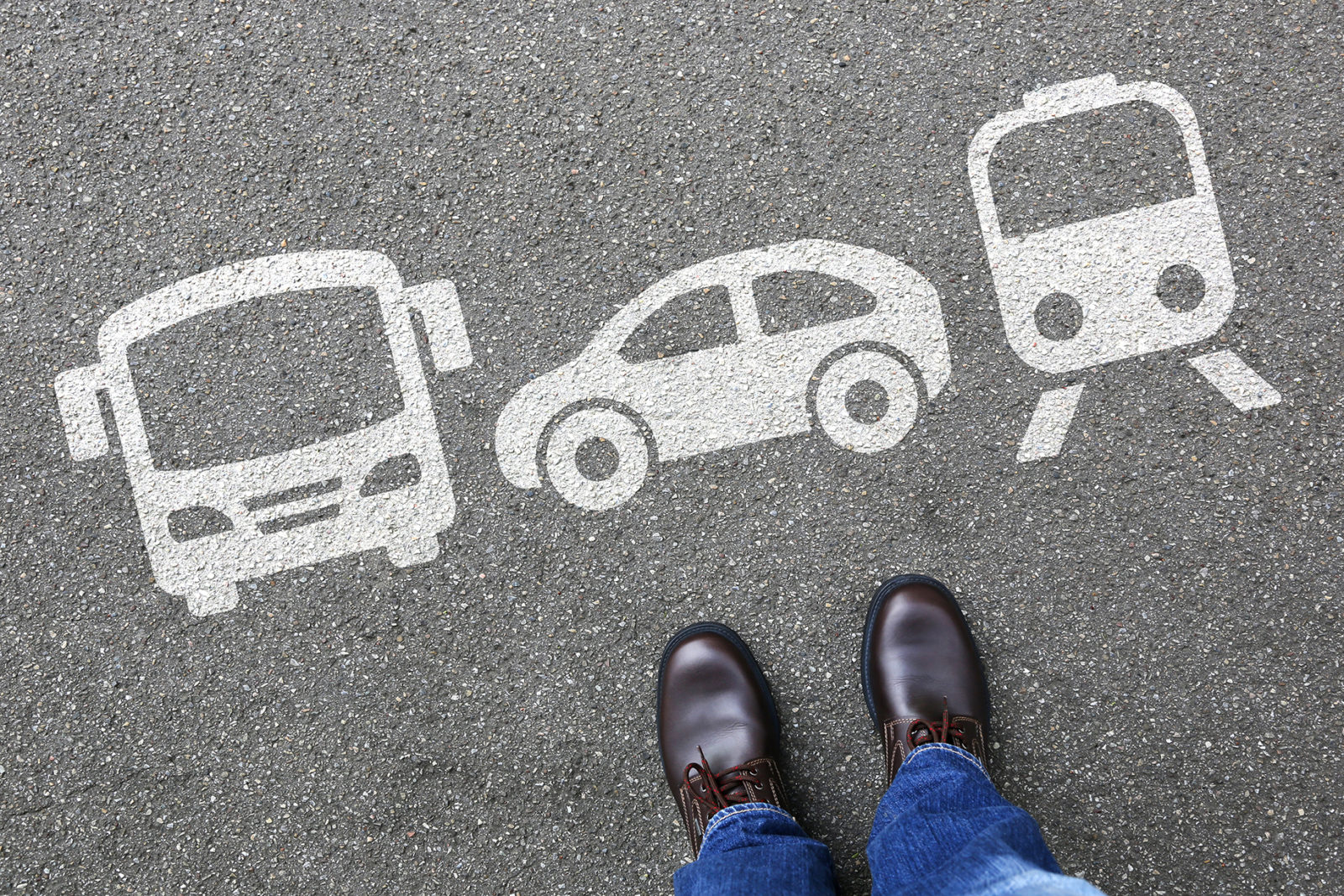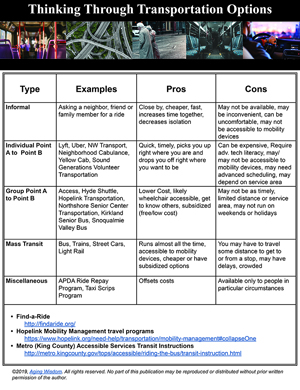Adventure to Alternative Transportation

As spring evolves and summer approaches, the Pacific Northwest begins to come alive. After the long winter, people of all ages are itching to get outside and move. But if your mobility needs are changing–what had previously been a time of excitement and adventure can become a challenge.
Perhaps during the snowstorms, you realized that it’s time to give up driving. Maybe it’s getting harder to walk several blocks to the bus stop. No matter what your situation, when things start to change, it can sometimes leave you with a feeling of, “What will I do then?”
 Luckily, there are several ways to answer this question. Because our mobility needs are many and varied, there are a wide range of options depending on your situation. Do you need a punctual ride to the doctor’s office? Are you more flexible about when you get to the library? Do you need to go during the week or on the weekend? Most likely, there is a form of transportation to help meet your need.
Luckily, there are several ways to answer this question. Because our mobility needs are many and varied, there are a wide range of options depending on your situation. Do you need a punctual ride to the doctor’s office? Are you more flexible about when you get to the library? Do you need to go during the week or on the weekend? Most likely, there is a form of transportation to help meet your need.
If you are not there yet, consider planning for how you will move about if and when your mobility needs change. A recent Bureau of Labor Statistics survey showed that transportation costs were the second largest expense (after housing and before food) for adults ages 55–74. It may be worth it to try out a few options now and include those in an overall mobility plan.
Following is a breakdown of transportation categories and options, along with a brief description of the pros and cons. A summary of each category and examples are provided in the table.
Informal Transportation
Neighbors, friends and family members are a great option when your transportation needs change. Neighbors are close by and riding with them can be a quick way to get anywhere you need to go. This method can also enhance relationships as car rides are a great time to talk. This option can also be cheaper depending on how you arrange the rides.
There are drawbacks, of course, to informal transportation. Family members may be working or have other commitments. It can be uncomfortable to ask for help and risk getting turned down. Lastly, friends may not have vehicles that can accommodate mobility devices (wheelchairs, scooters, walkers, etc.)
Individual Point A to Point B
Modern ridesharing services, more traditional taxicab services, and volunteer transportation services can be a great option if you need to get somewhere quickly and on time. Many companies run on weekends and holidays. Additionally, the service will pick you up right where you are and drop you off right where you want to be.
The downside to these services is that the costs can add up quickly. But perhaps it’s worth it for the occasional doctor’s visit. Some services may require a high level of technology access and literacy. Service may not be available in some parts of King County or may require advanced scheduling. Another consideration: only some services offer vehicles that can accommodate mobility devices.
Group Point A to Point B
Group Point A to Point B is the form of transportation most people are unaware of until they need it. These services pick up multiple individuals at different locations and may drop them all off at the same or various locations.
These options are great because they are generally subsidized and may have low or no out-of-pocket costs. Because you may be riding with other people, it can be an opportunity to talk with others and build community. They are usually accessible for mobility devices and easy to get in and out of.
The downside of these modes of transportation is that they may not be as timely. There is a lot of room for delays when picking up and dropping off multiple people. Additionally, the service area may be limited to certain neighborhoods, or to certain types of activities such as medical appointments. Finally, they may not run on weekends or holidays.
Mass Transit
Mass transit can be a good option if your reaction time or vision has changed, and you are still able to walk or use assistive devices to travel moderate distances. Mass transit runs almost all the time, including weekend and holidays (though schedules may vary). They are wheelchair accessible and can be cheaper or have subsidized options such as ORCA LIFT or, if you are age 65+, even better—the ORCA Regional Reduced Fair Permit
The downside is that you may have to travel several blocks to get to or from a stop. There may also be delays or long waits if you miss your ride. At peak hours mass transit can be crowded and difficult to navigate. Additionally, services are not available in all areas of King County.
Miscellaneous
There are a few other options that are not transportation per se but can help offset the cost of getting around. The Taxi Scrips program provides discounted taxi fares for individuals that qualify for the Regional Reduced Fair Permit. American Parkinson’s disease Association will reimburse individuals with Parkinson’s disease for qualifying transportation expenses up to $300 annually. Both of these programs are available only to individuals in particular circumstances.
There are many ways to get to where you are going, and it may take some time to learn a new transportation skill. When your mobility needs change, this task can feel especially challenging. However, the extra daylight hours make spring and summer a great time to try something new. Consider adventuring into alternative transportation!
 Contributor Mitchell Skidmore—a MSW student at the University of Washington—is completing his final year internship with Aging Wisdom. The University’s emphasis on multigenerational practice stood out to him because it not only sees individuals holistically, but also considers the generations above and below them. Mitchell encourages families and helps them navigate the complex challenges of aging well together.
Contributor Mitchell Skidmore—a MSW student at the University of Washington—is completing his final year internship with Aging Wisdom. The University’s emphasis on multigenerational practice stood out to him because it not only sees individuals holistically, but also considers the generations above and below them. Mitchell encourages families and helps them navigate the complex challenges of aging well together.
This article originally appeared in the April 2019 issue of AgeWise King County.
Find-A-Ride & Transit Instruction Resources
- Find-a-Ride is a great one-stop site for 24/7 accessible transportation info provided by Hopelink. It serves King, Snohomish, and Pierce county residents can sort by accessibility requirement. Transportation modes include local and regional transit, circulator buses, Hyde shuttles, water taxi, monorail, Amtrak, van pool, street car, ferries, non-emergency medical transportation, a few senior center vans, some specialized shuttles, Greyhound, airport shuttles, and taxi cabs.
- Hopelink Mobility Management travel programs empower people to change their lives by facilitating access to the community.
- Accessible Services Transit Instruction offered by Metro King County is also a useful option.
- King County Accessible Travel Map developed by the King County Mobility Coalition provides information about a wide range of transportation options for older people, including a Hyde Shuttle territory map.
![Aging & Disability Services for Seattle & King County [logo]](https://www.agingkingcounty.org/wp-content/themes/sads/images/seattle-ads-logo.png)